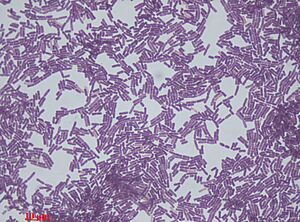Bacillus (shape) facts for kids

A bacillus (say: bah-SIL-us; plural: bacilli) is a type of tiny living thing called a bacterium. These bacteria are shaped like a small rod or a cylinder. Think of them like tiny, microscopic hot dogs!
The word "bacillus" can be a bit tricky because it has two meanings:
- When you see Bacillus written with a capital "B" and in italics, it refers to a specific group or genus of bacteria. For example, Bacillus anthracis is a well-known type.
- When "bacillus" is written with a small "b" and not in italics, it simply means any bacterium that has a rod shape.
So, not all rod-shaped bacteria belong to the Bacillus genus. Many different kinds of bacteria can have this shape.
Contents
What are Bacilli?
Bacilli are single-celled organisms, meaning they are made of just one cell. They are so small that you need a powerful microscope to see them. Like all bacteria, bacilli do not have a nucleus inside their cells.
These tiny rods are found almost everywhere! They live in soil, water, air, and even inside living things like plants and animals. Some bacilli are helpful, while others can cause diseases.
How Do We Identify Bacilli?
Scientists use special tests to identify different types of bacteria. One common test is called Gram staining. This test helps scientists see if a bacterium has a thick or thin outer wall.
- Bacteria with thick walls turn purple in the Gram stain and are called "Gram-positive."
- Bacteria with thin walls turn pink or red and are called "Gram-negative."
It's important to know that the shape of a bacterium (like being a bacillus) has nothing to do with whether it's Gram-positive or Gram-negative. You can find both Gram-positive and Gram-negative bacilli.
Where Do Bacilli Live?
Bacilli are incredibly adaptable. They can live in many different environments, from hot springs to icy tundras. Many types of bacilli live in the soil, where they play a very important role.
Some bacilli live inside the bodies of animals, including humans. For example, some helpful bacilli live in our intestines and help us digest food.
Why are Bacilli Important?
Bacilli are very important for life on Earth. They do many jobs that keep our planet healthy and help humans in different ways.
Helpful Bacilli
Many bacilli are beneficial. Here are a few examples:
- Soil Health: Many bacilli in the soil help break down dead plants and animals. This process, called decomposition, returns nutrients to the soil, making it fertile for new plants to grow.
- Food Production: Some bacilli are used to make certain foods. For instance, some types help ferment foods like kimchi or sauerkraut.
- Medicine: Scientists use some bacilli to produce antibiotics, which are medicines that fight harmful bacteria.
- Biotechnology: Certain bacilli are used in industries to create enzymes or other useful chemicals.
Harmful Bacilli
While many bacilli are helpful, some can cause diseases in humans, animals, or plants.
- Bacillus anthracis is a well-known example that causes anthrax, a serious disease.
- Clostridium botulinum (which is a rod-shaped bacterium, so it's a bacillus) produces a powerful toxin that can cause botulism, a type of food poisoning.
Scientists study these harmful bacilli to understand how they cause disease and to develop ways to prevent and treat infections.
See also
 In Spanish: Bacilo para niños
In Spanish: Bacilo para niños

